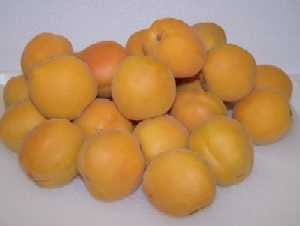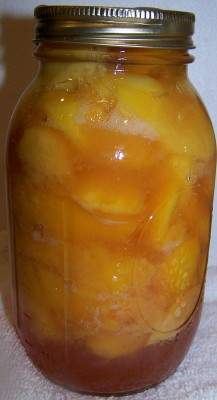
Apricot facts and picking tips
 Apricot Facts, Picking Tips and Recipes
Apricot Facts, Picking Tips and Recipes
In the U.S., Apricots typically peak from June through July in the South, and July and August in the North. In order to produce good local apricots, producers depend on ideal spring and early summer weather conditions, and no late frosts. If you want to know which are the best varieties of apricots for home canning, see this page!
Before you leave to go to the farm:
- Always call before you go to the farm - Apricots are affected by weather (both rain and cooler temperature) more than most crops. And when they are in season, a large turnout can pick a field clean before noon, so CALL first!
-
 Leave
early. On weekends, then fields may be picked clean by NOON!
Leave
early. On weekends, then fields may be picked clean by NOON! -
Most growers furnish picking containers designed for apricots, but they may
charge you for them; be sure to call before you go to see if you need to
bring
containers.
If you use your own containers, remember that heaping Apricots on top of each other will bruise the fruit on the bottom. Plastic dishpans, metal oven pans with 3 inch tall sides and large pots make good containers, so you can spread them out. - Bring something to drink and a few snacks; you'd be surprised how you can work up a thirst and appetite! And don't forget hats and sunscreen for the sun. Bugs usually aren't a problem, but some deet might be good to bring along if it has been rainy.
- You might want to ask whether the apricots are! There are two major types of apricots: "Freestone" and. "Clingstone". Freestone apricots and nectarines have flesh that slips easily away from the pit. Clingstones are a REAL pain, because the fruit tenaciously clings to the stone or pit! Most apricot varieties grown today are freestone and are usually available (depending upon your location) from June through September. Some nectarines are freestone and some are clingstone. Freestone nectarines are available in June and July. Most plum varieties are clingstone.
When you get home
- Spread the fruit out on towels or newspapers and separate any mushy or damaged fruit to use immediately.
- Put a couple of days supply into the fridge, wash and cut the others and freeze them up!
- Even under ideal conditions apricots will only keep for a week in a refrigerator, so for best flavor and texture, use them as soon as possible after purchase
- Now, get ready to make Apricot jam or canned apricots - It is VERY easy - especially with our free directions and recipes:
How to tell if the apricots are ripe!
- Attached to the tree: Apricots are best picked when the fruit separates easily from the twigs. If it is hard to pull off the tree, it isn't ripe! Apricots will not ripen further once removed from the tree (they only "soften")
- Color: Green is definitely unripe, but you can't use red color as an indicator of how ripe a apricot is. Different apricot varieties have differing amounts of red blush in their natural coloring. Pick them when the ground color changes from green to yellow, orange, red (or a combination). The skin of yellow-fleshed varieties ripens to an orange tint, while the skin of white-fleshed varieties changes from greenish- to yellow-white.
- Softness: unless you like your apricots very firm, pick your apricots with just a little "give" when gently pressed. Apricots at this stage are great for eating, freezing, and baking. Apricots won't ripen very much after picking!
- Odor: It should smell sweet and ripe!
Tips on How to Pick Apricots
A apricot is softer than most fruit, so it is important to pick a apricot gently, with little pressure. Using the sides of your fingers rather your fingertips helps to avoid bruising. Grab the apricot firmly and pull it straight off the branch. DON'T drop the apricot into the basket, but set it in gently!
Marks on the Apricots: Bugs (particularly squash bugs and stink bugs) bite fruit during development and this results in some imperfections in the apricot. This is especially the case with organically raised fruit. These look like dents in the apricots if the apricots were bitten by a bug when they were young. This causes a spot that does not grow properly and makes a wrinkle in the apricot. There's nothing wrong with these apricots. They may look funny, but they will taste just as good as blemish-free apricots, and it's better not to have the pesticides!
Apricot Canning, Freezing and Recipes
- How to make Apricot jam
- Canning apricots
- How to freeze apricots
- Here are some great and easy apricot desert recipes, like easy apricot cobbler.
How much do you need?
Raw measures:
- About 6 medium apricots = 1 cup sliced apricots.
- About 4 medium apricots = 1 cup pureed apricot.
- 1 pound fresh apricots = 8 to 12 whole fruits
Process yields (Raw amounts to processed amounts)
- 2 to 21/2 pounds of fresh apricots yields 1 quart canned
- 2-1/2 pounds fresh apricots = 2 to 3 pints frozen
- 1 lb of fresh apricots typically yields 3 cups of peeled, sliced apricots or 2 cups or puree.
- It takes about 5 good sizes apricots or nectarines (or about 10 plums) to fill one quart jar of canned apricots.
- An average of 17 -1/2 pounds of fresh apricots are needed per canner load of 7 quarts;
- An average of 11 pounds is needed per canner load of 9 pints.
- 1 bushel = 48 to 50 pounds, yields approximately 18 to 25 quart jars.
Apricots-Average retail price per pound and per cup equivalent
Canned Apricots
- 16-ounce can apricots = 2 cups drained
Dried Apricots
- 6 pounds fresh apricots = 1 pound dried apricots
- 1 pound dried apricots = 2-3/4 cups
- 1 pound dried apricots = 5 cups cooked
- 6 ounces dried apricots = 1 cup
- 6 ounces dried apricots = 2 cups cooked
Apricot pit tips
It's best to remove apricot pits before you cook the apricots. Cherry, apricot, and apricot pits also contain amygdalin; the latter two, in potentially harmful amounts. Fortunately, apricot and apricot pits are sufficiently large and hard that few people intentionally swallow or chew them. (The unapproved anti-cancer drug Laetrile is a semisynthetic derivative of amygdalin; a cheaper version of laetrile produced in Mexico came from crushed apricot pits.) See this page for more information.
Nutritional Information
apricots
Delicious and Nutritious
a delicious
&
natural
treat10g 0 g 0 m 0 mg 1.5 g 47RE
- apricots are virtually fat free. A medium size apricot contains less than one gram of fat.
- apricots are naturally sodium free.
- apricots have no cholesterol.
- apricots are a low calorie snack. A medium size apricot contains only 40 calories.
- apricots contain vitamin A which helps us see in dim light.
- apricots are considered a good source of fiber. The skin of a apricot provides both roughage and fiber.
Temporary Storage Tips
- Ripe apricots have a creamy or golden undertone and "apricoty-sweet" fragrance.
- Apricots should be refrigerated and used within a few days.
- Putting apricots and nectarines in a loosely closed paper bag at room temperature for a day or two can help soften firm fruit - but they won't become sweeter or ripen further - that stopped when they were removed from th etree.
- For best flavor, allow the fruit to ripen fully on the tree.
- Store at 33°F to 40°F and high humidity (a vegetable drawer in the fridge).
Preserving the fruit
- For canning directions,
 See
my page on how to make home
canned apricots from fresh! It is really SO easy!
See
my page on how to make home
canned apricots from fresh! It is really SO easy! - Freezing Apricots
 See
my page on how to freeze
apricots, plums, nectarines, figs and cherries. Even easier than canning
and they will taste just like fresh.. but it does take up space in the
freezer.
See
my page on how to freeze
apricots, plums, nectarines, figs and cherries. Even easier than canning
and they will taste just like fresh.. but it does take up space in the
freezer.Question: Which is better, to can or freeze apricots?
Answer: In my experience, going back 50 years to my childhood, when my mother also canned and froze apricots, we both found that frozen were superior in color and flavor to canned apricots. It all depends upon whether you have room in your freezer.
- Apricot butter
If you like apple butter and you like apricots, you will LOVE this easy apricot butter recipe, complete with canning instructions, so you can make them now and give them away at Christmas time!
- Apricot jam - it is out of this world and SO easy.
- How to make apricot chutney
- Spiced Apricots
A favorite, canned spiced apricots, just the same as spiced peaches! - Apricot Cobbler
This recipe is easy and DELICIOUS!!! - Even more apricot and nectarine recipes: Apricot Honey, Marmalade, Conserves, Apricot Pickles and Oscar Relish
Substituting Frozen or Canned Apricots for Fresh
In most recipes, frozen or canned apricots can be substituted for fresh apricots. The frozen and canned apricots have already been sweetened; therefore, the amount of sugar called for in a recipe will have to be adjusted. Also, the apricots should usually be drained before using.
Grow your own apricots?
Most commercial apricots are griwn in California and other southern states. But if you live in U.S. Department of Agriculture plant hardiness zones 4 through 9.which is most of the US you can grow apricots. You can plant only one tree if you want, since mostapricots varieties are self-pollinating. The trees are covered in pretty white or pink flowers in in early spring and produce a substantial crop per tree.
Looking for canning equipment and supplies?
Water bath canner with a jar rack
Pressure canners for gas, electric and induction stoves: Presto 23Qt or T-fal 22Qt
Canning scoop (this one is PERFECT)
Ball Blue book (most recent version)
Jars: 8oz canning jars for jams
Find Other types of farms:
Farm markets and roadside stands
Road trips and camping resources
Local Honey, apiaries, beekeepers
Consumer fraud and scams information
Home canning supplies at the best prices on the internet!
Maple Syrup Farms, sugarworks, maple syrup festivals
Environmental information and resources
Farms For Your Event for birthday parties, weddings, receptions, business meetings, retreats, etc.
Festivals - local fruit and vegetable festivals
Get the
most recent version of
the Ball Blue Book
With this Presto 23 quart pressure canner and pressure cooker, you can "can" everything, fruits, vegetables, jams, jellies, salsa, applesauce, pickles, even meats, soups, stews. Model 01781

You can make jams, jellies, can fruit, applesauce, salsa and pickles with water bath canners, like this Granite Ware 12-Piece Canner Kit, Jar Rack, Blancher, Colander and 5 piece Canning Tool Set

